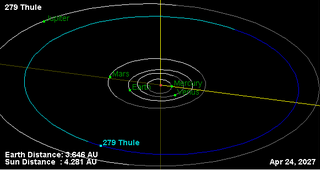Related Research Articles

Circe, minor planet designation 34 Circe, is a large, very dark main-belt asteroid. It was discovered by French astronomer J. Chacornac on April 6, 1855, and named after Circe, the bewitching queen of Aeaea island in Greek mythology.

Penelope is a large main belt asteroid that was discovered by Austrian astronomer Johann Palisa on August 7, 1879, in Pola. The asteroid is named after Penelope, the wife of Odysseus in Homer's The Odyssey. It is orbiting the Sun at a distance of 2.68 AU with an eccentricity (ovalness) of 0.18 and a period of 4.381 years. The orbital plane is tilted at an angle of 5.8° to the plane of the ecliptic.

Eos is a large main-belt asteroid that was discovered by Austrian astronomer Johann Palisa on January 18, 1882, in Vienna. In 1884, it was named after Eos, the Greek goddess of the dawn, to honour the opening of a new observatory that was hoped to bring about a new dawn for Viennese astronomy.

Eukrate is a rather large main-belt asteroid. It is dark and probably a primitive carbonaceous body. The asteroid was discovered by Robert Luther on March 14, 1885, in Düsseldorf. It was named after Eucrate, a Nereid in Greek mythology.

Silesia is a large Main belt asteroid, about 73 kilometers in diameter. It was discovered by Johann Palisa on 5 April 1886 at Vienna Observatory, Austria.

Justitia is a fairly sizeable main belt asteroid around 50km in diameter

Thule, minor planet designation: 279 Thule, is a large asteroid from the outer asteroid belt. It is classified as a D-type asteroid and is probably composed of organic-rich silicates, carbon and anhydrous silicates. Thule was the first asteroid discovered with a semi-major axis greater than 4 AU. It was discovered by Johann Palisa on 25 October 1888 in Vienna and was named after the ultimate northern land of Thule.

Apolonia is a large Main belt asteroid. It was discovered by Auguste Charlois on 8 March 1893 in Nice.

Cyane is a typical Main belt asteroid.

Suevia is a typical Main belt asteroid. It is classified as a K-type/S-type asteroid.

Princetonia is a large asteroid, a type of minor planet, orbiting in the asteroid belt. It was discovered by Raymond Smith Dugan at Heidelberg, Germany in 1903 and named "Princetonia" for Princeton University in New Jersey in the United States.
Messalina is a minor planet, specifically an asteroid orbiting primarily in the asteroid belt. It was discovered on 3 October 1904 by Paul Götz, at Heidelberg. It is named after Valeria Messalina, the third wife of Roman Emperor Claudius.

714 Ulula is a main belt asteroid. It is orbiting the Sun near the 3:1 Kirkwood Gap with a period of 4.04 years and an eccentricity of 0.057. It was discovered by German astronomer J. Helffrich on 18 May 1911 from the Heidelberg Observatory and was named after an order of owls. The asteroid has a mean radius of 20 km and is spinning with a rotation period of seven hours. Its pole of rotation lies just 4–14° away from the plane of the ecliptic. The surface spectrum shows a pyroxene chemistry and is consistent with mesosiderites/HED meteorites.

753 Tiflis is a minor planet orbiting the Sun. It was discovered 30 April 1913 by the Georgian–Russian astronomer Grigory N. Neujmin at Simeiz Observatory and was named after Georgia's capital city Tiflis. The object is orbiting the Sun at a distance of 2.33 AU with a period of 3.55 years and an eccentricity (ovalness) of 0.22. The orbital plane is inclined by an angle of 10.1° to the plane of the ecliptic. In 1991, Ruth F. Wolfe included it as a member of the proposed Tiflis asteroid family.
781 Kartvelia is a minor planet orbiting the Sun that was discovered by Russian astronomer Grigory Neujmin on January 25, 1914. Kartvelia comes from the historic name for the inhabitants of the nation of Georgia. This object is orbiting at a distance of 3.22 AU with an eccentricity (ovalness) of 0.12 and a period of 5.78 yr. The orbital plane is inclined at an angle of 19.1° to the plane of the ecliptic.
804 Hispania is a minor planet orbiting the Sun. It was discovered from Barcelona (Spain) on 20 March 1915 by Josep Comas Solá (1868–1937), the first asteroid to be discovered by a Spaniard.
933 Susi is a minor planet orbiting the Sun.
935 Clivia belongs to the Flora family of Main Belt asteroids. Its diameter is about 7.9 km and it has an albedo of 0.197 .
6239 Minos is a bright sub-kilometer near-Earth object, classified as a potentially hazardous asteroid of the Apollo group. It was discovered on 31 August 1989, by American astronomer couple Carolyn and Eugene Shoemaker at the Palomar Observatory in California. The asteroid has a rotation period of 3.6 hours and measures approximately 0.5 kilometers in diameter. It makes frequent close approaches to Mars, Earth, and Venus.
5731 Zeus is an Apollo asteroid and near-Earth object discovered on 4 November 1988, by Carolyn Shoemaker at Palomar Observatory. Based on its observed brightness and assumed albedo it is estimated to have a diameter between 2.1 and 4.7 km.
References
- ↑ "Transvaal". Lexico UK English Dictionary. Oxford University Press. Archived from the original on 22 March 2020., stress per "Transvaalian" . Oxford English Dictionary (Online ed.). Oxford University Press.(Subscription or participating institution membership required.)
- ↑ "715 Transvaalia (1911 LX)". JPL Small-Body Database . NASA/Jet Propulsion Laboratory . Retrieved 5 May 2016.